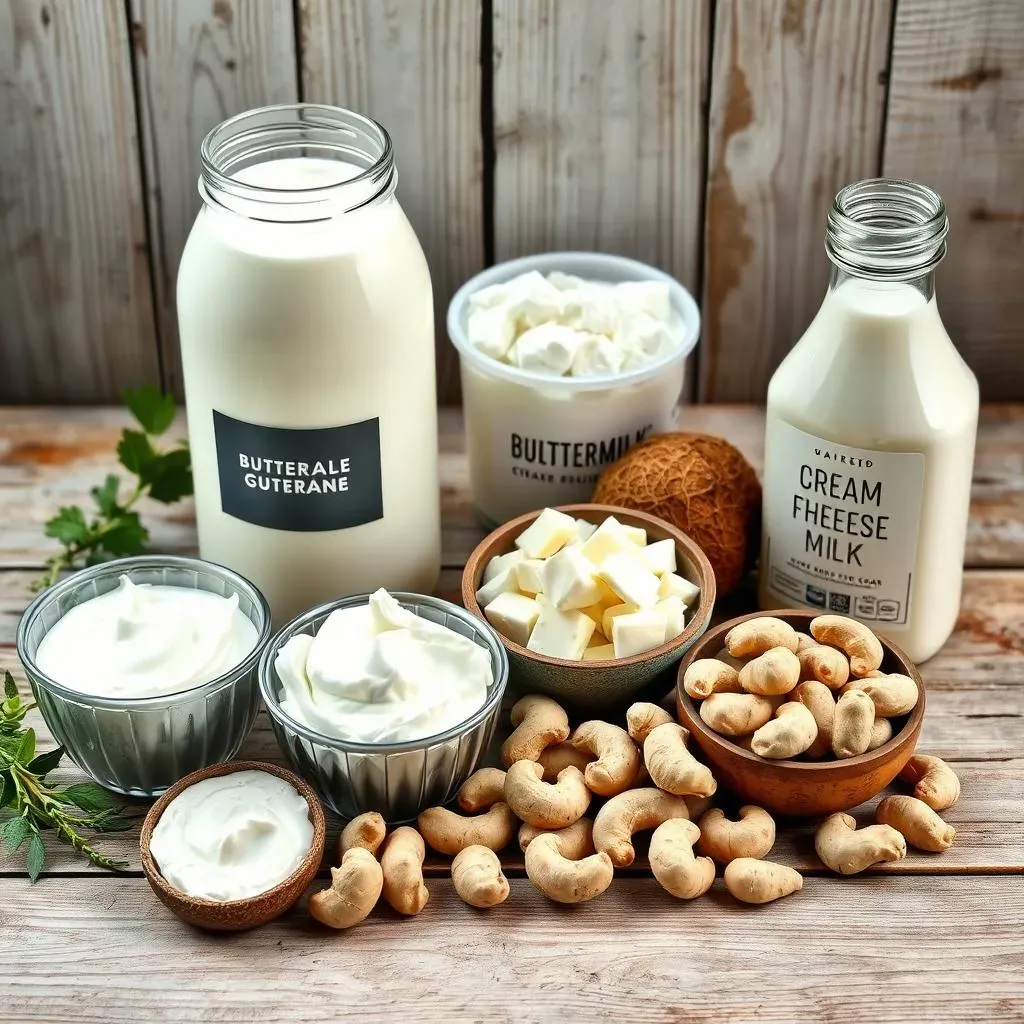Table of Contents
Ever found yourself mid-recipe, only to realize you're completely out of sour cream? It's a kitchen crisis we've all faced. That tangy, creamy goodness seems irreplaceable, doesn't it? But hold on, before you abandon your culinary masterpiece, there's good news! I'm here to tell you that there are plenty of fantastic options that can step in and save the day. This article will explore the world of sour cream substitutes, showing you that "what can be a substitute for sour cream" isn't a question with just one answer. From common dairy products to clever plant-based alternatives, we'll uncover ten amazing ingredients that can mimic the flavor and texture of sour cream. Whether you're baking a cake, whipping up a dip, or topping off your tacos, you'll discover the perfect substitute that will make your dish sing. So, get ready to explore these alternatives and say goodbye to sour cream emergencies forever. I'll walk you through each substitute, explaining when to use it and how it might alter your final dish. Let’s get started!
Top 10 Sour Cream Substitutes: What Can Be a Substitute for Sour Cream

Top 10 Sour Cream Substitutes: What Can Be a Substitute for Sour Cream
The Yogurt Champion
Okay, so you're staring into the fridge, the recipe book is open, and BAM! No sour cream. Don't panic. First up, we have yogurt, it's like the superhero of sour cream substitutes. Seriously, it's often the best option. Plain yogurt, especially Greek yogurt, has that tangy flavor and creamy texture that's very similar to sour cream. You can use it in a 1:1 ratio, meaning if your recipe calls for one cup of sour cream, just swap it with one cup of yogurt. It works amazingly well in dips, sauces, and even baked goods. Just make sure you grab the unflavored kind, unless you fancy a sweet twist in your chili.
I've used yogurt in so many recipes, and it always delivers. Last week I made a killer potato salad and swapped the sour cream for Greek yogurt. Nobody even noticed the difference! It's a great way to sneak in some extra protein too. But just be aware, if you're using regular yogurt, it might be a bit thinner than sour cream, so you might need to adjust the other liquids in your recipe. Give it a shot. You won't regret it.
Mayonnaise: The Tangy Stand-in
Next on our list, we've got mayonnaise. Now, I know what you're thinking, “mayo in place of sour cream?” Hear me out, it's not as crazy as it sounds. Mayonnaise has a similar creamy texture, though it does lack that distinctive tang that sour cream brings to the party. You can use it as a 1:1 substitute too, which is super convenient. It's especially great for things like dips and dressings where you need that creamy base. However, if you're using it in something that needs a bit of a zing, you might want to add a splash of lemon juice or vinegar to give it that extra kick.
I remember one time, I was making a creamy pasta sauce and realized I was out of sour cream. I was about to give up when I saw the jar of mayo in the fridge. I thought, "Why not?" It actually turned out really good! The sauce was rich and creamy, and the little bit of lemon juice I added gave it the needed tang. Just remember, mayonnaise is milder, so you might need to play around with the seasonings to get your flavor profile just right. It's all about experimenting and having fun in the kitchen, right?
Substitute | Ratio | Best For | Notes |
|---|---|---|---|
Yogurt (Greek or Plain) | 1:1 | Dips, sauces, baking | Use unflavored; may need to adjust liquids. |
Mayonnaise | 1:1 | Dips, dressings, creamy sauces | Milder flavor; add lemon juice or vinegar for tang. |
Dairy and NonDairy Options for Sour Cream Substitutes

Dairy and NonDairy Options for Sour Cream Substitutes
Buttermilk: The Thin but Tangy Choice
Alright, let's talk buttermilk. It's another dairy option, and while it's not as thick as sour cream, it's got that tangy flavor we need. Think of it as sour cream's slightly rebellious cousin. Buttermilk is definitely thinner, so it won’t give you the same creamy texture straight up. However, you can use it in a pinch, especially in baking. It can add a lovely tang to cakes, pancakes, and muffins. If you need a thicker consistency, try whisking it with a little melted butter, cream cheese, or even some Greek yogurt. That’ll help it get closer to that sour cream texture. It's not a perfect swap, but it’s a good option to keep in mind.
I once tried using buttermilk in a batch of scones when I was out of sour cream, and they came out surprisingly fluffy and tangy. The texture was a bit different, but the flavor was spot on. Just remember, since it’s liquidy, you may need to adjust the other liquids in your recipe to avoid making your batter too runny. It is a bit of a balancing act, but it can be done! Don't be afraid to experiment and see what works best for you.
Cream Cheese and Crème Fraîche: Rich and Indulgent
Now, if you're looking for something really rich, let's talk cream cheese and crème fraîche. Cream cheese is super thick and creamy, and while it doesn't have that same tang as sour cream, it can work wonders in dips and sauces. I like to soften it up a bit before using it as a substitute, it makes it easier to blend. Crème fraîche, on the other hand, is like sour cream's fancy French cousin. It has a similar tang, but it's richer and smoother. You can use it in a 1:1 ratio in most recipes. Both options will give you a luxurious texture that's hard to resist, so if you’re aiming for that decadent feel, these are great choices. They're not exactly sour cream, but they bring their own unique charm.
I’ve used cream cheese in a pinch for a quick spinach dip, and it was a total hit. The dip was thick, and the cream cheese gave it a wonderful richness. Crème fraîche is amazing when you want to elevate a dish, like a creamy pasta sauce or a soup. It's a bit more expensive than sour cream, but sometimes the extra indulgence is worth it. Just remember, both are quite rich, so you might want to use a little less if you're watching your calorie intake. They’re not everyday swaps, but for special occasions, they're pretty awesome.
Substitute | Ratio | Best For | Notes |
|---|---|---|---|
Buttermilk | 2-3 tablespoons for 1/4 cup sour cream | Baking, some sauces | Thinner; may need thickening or liquid adjustment. |
Cream Cheese | 1:1 | Dips, sauces | Soften before using; richer texture. |
Crème Fraîche | 1:1 | Dips, sauces, toppings | Richer, smoother, and tangier than sour cream. |
Coconut Milk and Cashews: The Vegan Wonders
Okay, now let’s talk about the non-dairy options. If you’re vegan or just trying to avoid dairy, coconut milk and cashews are your new best friends. Coconut milk, particularly the full-fat version, can be a great substitute for sour cream in many recipes. It adds a creamy texture and a slight sweetness, which can work really well in things like curries and soups. Make sure to use the thick part from the top of the can. Cashews, on the other hand, might seem like a strange choice, but when blended, they create a super smooth and creamy texture. You can soak them in hot water for a bit to make them easier to blend. They make an amazing vegan sour cream substitute, especially when you add a splash of lemon juice or vinegar for that tang.
I've seen people use coconut milk in vegan tacos with fantastic results. It adds a rich and creamy element that you don’t miss the dairy at all. And cashew cream? It's like magic! I once used it as a topping for a vegan chili, and it was so good that no one could believe it was made from nuts. It’s a bit more work, but the results are worth it. So, if you’re exploring the dairy-free world, definitely give these options a try. They’re not just substitutes; they're fantastic ingredients in their own right. These options can also be used as a sour cream replacement.
How to Use Sour Cream Substitutes in Your Recipes

How to Use Sour Cream Substitutes in Your Recipes
Baking with Substitutes: A Balancing Act
So, you've got your substitute, now what? When it comes to baking, it’s all about balance. If you're using yogurt or buttermilk, remember they're thinner than sour cream. This means you might need to reduce the amount of other liquids in your recipe. Start by swapping the sour cream 1:1 and see how your batter looks. If it seems too runny, add a tablespoon or two of flour or other dry ingredients to thicken it up. Also, be mindful of the flavor. If you're using something like mayonnaise, which is milder, you might want to add a touch of lemon juice or vinegar to mimic that tang. Baking is a science, but it’s also an art, so don’t be afraid to experiment.
I've had my fair share of baking mishaps, but they've taught me a lot. Once, I used buttermilk in a cake recipe, and it turned out a bit too moist. The next time, I reduced the amount of milk and added a bit more flour, and it was perfect! It's all about learning from your mistakes and tweaking the recipe until you get it just right. So, take notes, have fun, and don’t be afraid to get a little messy!
Dips and Sauces: Creamy Creations
When it comes to dips and sauces, you’ve got a bit more flexibility with your substitutes. Yogurt, mayonnaise, cream cheese, and crème fraîche all work beautifully as creamy bases. Just remember, each substitute brings its own unique flavor profile. If you're using mayonnaise, add a splash of lemon juice or vinegar for that tang. If you're using cream cheese, soften it up a bit before mixing so it blends smoothly. For coconut milk, use the thick part from the top of the can for the best texture. And don't forget to taste as you go! Seasoning is key to getting the flavor just right. Adjust the herbs, spices, and salt to your liking and you’ll have a dip or sauce that’s every bit as good as the original.
I love using yogurt in my tzatziki sauce. It’s creamy, tangy, and tastes amazing with veggies or pita bread. I’ve also used cashew cream in a vegan queso dip, and it was a huge success! The key is to start with a good base and then build up the flavors. It’s all about layering tastes and textures. And remember, a little bit of lemon juice or vinegar can go a long way in mimicking that sour cream tang. Don't be afraid to get creative and try new combinations. The possibilities are endless!
Substitute | Adjustments for Baking | Adjustments for Dips/Sauces |
|---|---|---|
Yogurt | Reduce other liquids; add dry ingredients if needed. | Use unflavored; can be used 1:1. |
Mayonnaise | Add lemon juice or vinegar for tang. | Add lemon juice or vinegar for tang; use 1:1. |
Buttermilk | Reduce other liquids; may need thickening. | Can use as is, or thicken with butter or yogurt. |
Cream Cheese | Soften before using; may be too thick on its own. | Soften before using, blend well. |
Crème Fraîche | Can be used as is; may be richer. | Can be used as is; richer texture. |
Coconut Milk | Use thick part of can. | Use thick part of can. |
Cashews | Soak and blend for smooth texture. | Soak and blend for smooth texture; add lemon juice. |
Experimentation is Key
The most important thing to remember is that cooking is all about experimenting. Don’t be afraid to try different substitutes and see what works best for you. Start with the recommended ratios and then adjust according to your taste and the recipe's needs. Sometimes you might find a substitute that you like even better than sour cream! The key is to have fun, be patient, and embrace the process. Every kitchen mishap is a learning opportunity, so don’t let a few kitchen fails discourage you. It’s all part of the cooking adventure.
I've learned so much from my kitchen experiments. I've had cakes that were too dense, dips that were too runny, and sauces that tasted a bit off. But with each mistake, I learned something new and improved my cooking skills. So, don't be afraid to get in the kitchen, try new things, and see what delicious creations you can come up with! Remember, there's no single "right" answer when it comes to cooking – it’s all about finding what works best for you. So, go ahead, get creative, and have fun with your sour cream substitutes!